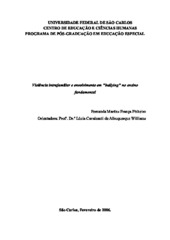Violência intrafamiliar e envolvimento em "bullying"no ensino fundamental
Abstract
Many studies have shown that children exposed to domestic violence are at risk of presenting behavior problems and other adjustment problems at school. Nevertheless, few studies have assessed the relationship between different types of family violence and bullying. The primary purpose of the present investigation was to: a) examine the relationship between bullying and different types of direct and indirect family violence in Brazil; b) check the chronicity of family violence among student subgroups implied in bullying; c) establish if there are gender differences concerning these associations. The research was conducted with 239 grades 5-8 students, of which 34.7% were boys and 65.3% girls. A questionnaire was constructed based on other instruments,
containing: 12 questions involving socio-demographic variables; 16 items of the Revised Conflict Tactic Scale (CTS-2), with the goal of examining the youngster s exposure to interparental physical and psychological violence; and 32 items of the Parent-Child Conflict Tactics Scales (CTSPC), concerning physical and psychological abuse committed by parents against children. Bullying and victimization were measured by 26 items developed specially for the study s purpose, based on a modified version of Olweus questionnaire. It was found that, in the previous three months before the study, 49% of all students were implied in bullying: 2,9% as bullies, 25,5% as victims and 20,5% as bully/victims. It was found that boys were more implied as bully/victims than girls. More than 50% of the participants had witnessed at least one episode of interparental psychological aggression, and 12% of all students reported seeing physical violence between parents, with fathers and mothers showing an equal ratio of violence. In regards to child abuse, psychological violence was the most frequent modality, with 85% of participants reporting that they had been victimized that way by mothers and 62%, by fathers. The rates of physical assault were also alarming: about 70% of all students reported that they had suffered corporal punishment by parents, which is worrisome. Associations were found between bullying and domestic violence, but these
associations were different according to gender. Being exposed to domestic violence was associated with being a bully/victim in school (especially for girls), but not with being a victim of bullying. On the other hand, parental violence increased the probability of boys reporting being implied in bullying as victims or as bully/victims. In terms of the girls, suffering parental violence was only associated as being a
bully/victim. In this study, being an aggressive-victim meant having more chance of suffering domestic violence, and such violence was more severe than the one reported by students not implied in bullying or victims of bullying only. Due to the small amount of participants classified as bullies, it was not possible to do statistical tests, which was a limitation of the study.
